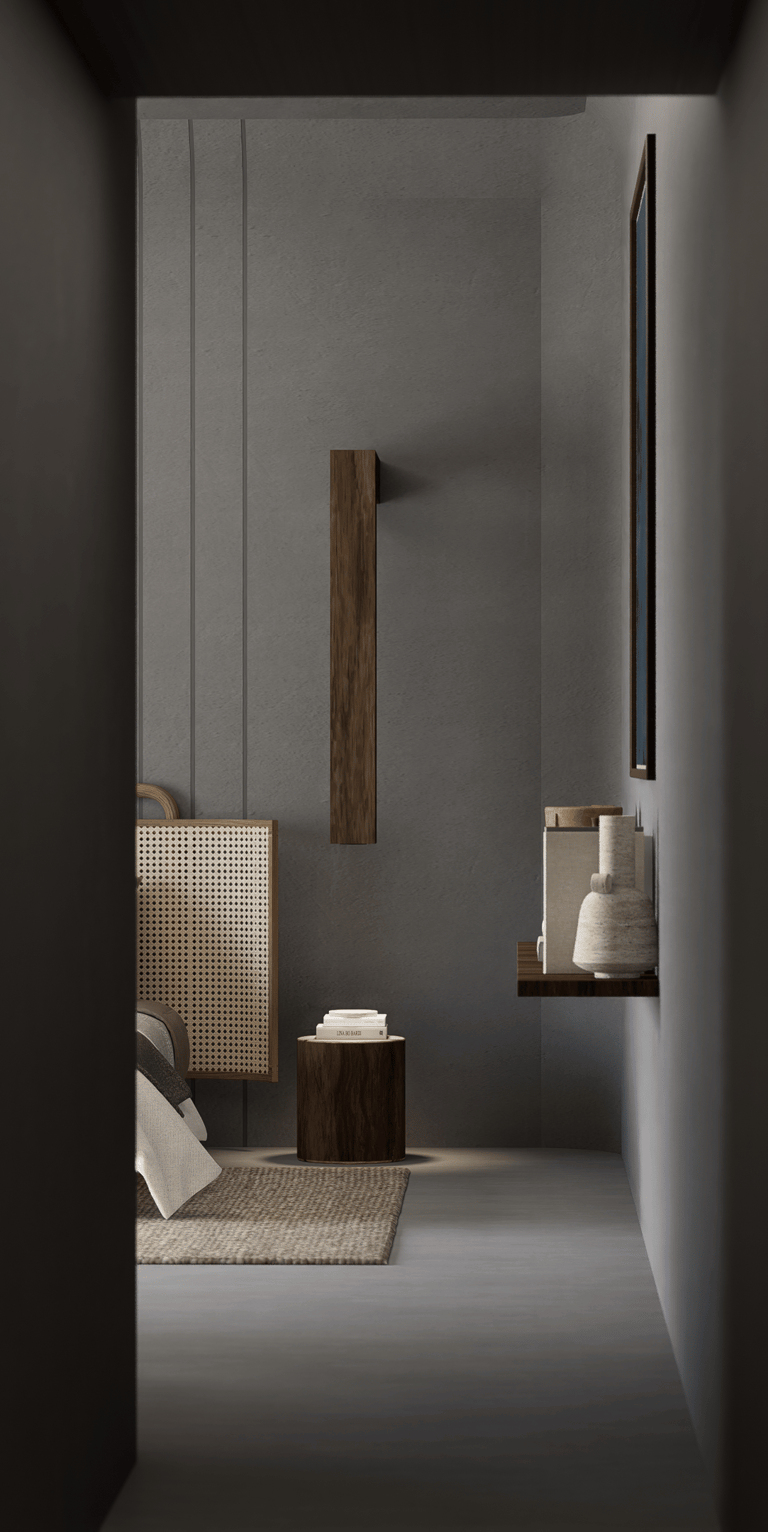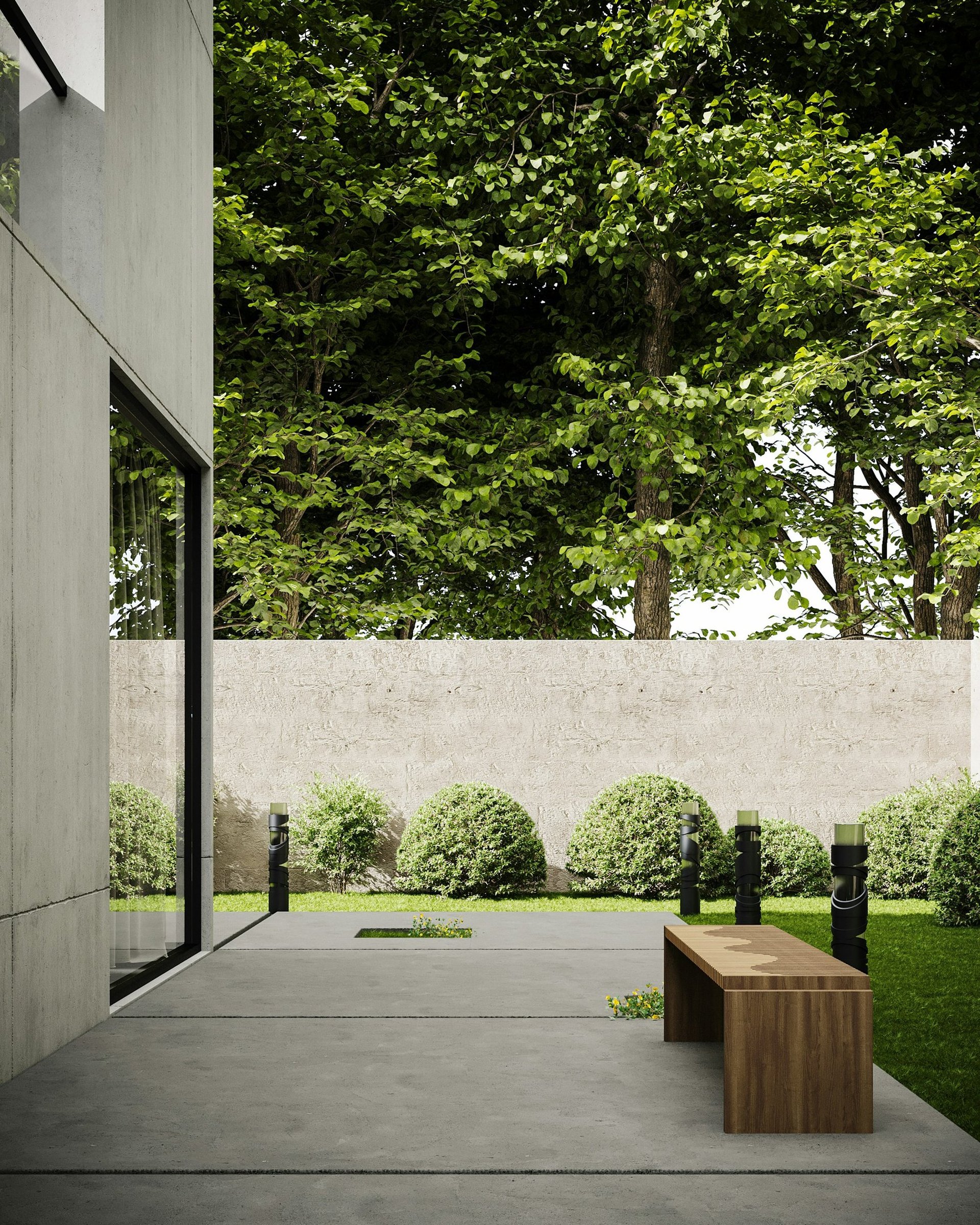
Building Outdoor Spaces That Endure in the UAE
Landscaping Design Guide
Creating a landscape in the UAE goes beyond mere aesthetics. The local climate, soil conditions, water resources, and regulatory requirements need to address technical challenges first. Neglecting these factors can lead to the rapid decline of even the most visually appealing gardens. This guide focuses on informed decision-making, selecting durable materials and plants, and designing outdoor spaces that are both attractive and resilient.


Plants & Materials: What Stands the Test of Time

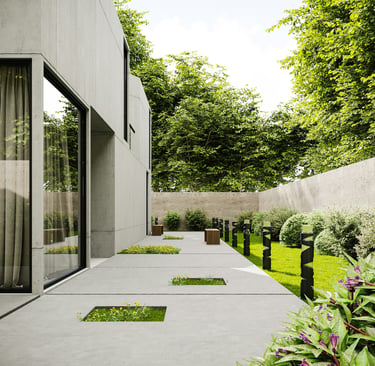
Once you've laid the groundwork, your choices regarding materials and plants will significantly influence how long your landscape remains vibrant and sustainable.
Plants
Native and Adapted Species
Opt for native or well-adapted species like the Ghaf tree (Prosopis cineraria), various Acacias, and Date Palms, along with local shrubs and succulents. These plants thrive in intense heat, drought conditions, and poor soil, making them ideal for the UAE's challenging environment.
Seasonal vs. Perennial Choices
While seasonal annuals can offer bursts of color, they require regular replacement and additional watering. In contrast, perennials and native trees not only provide lasting structure but also demand lower maintenance in the long run, freeing you to enjoy your garden rather than constantly working on it.
Layered Planting
Consider a layered approach: trees, followed by shrubs, groundcovers, and trailing plants or climbers. This strategy helps to shade the soil, suppress weeds, and minimize irrigation needs, creating an ecosystem that supports itself and reduces your gardening workload.
Grass and Lawn Options
If you prefer natural grass, seek out heat- and drought-resistant varieties such as Bermuda or Zoysia. Alternatively, artificial turf can be a smart choice for specific areas, as long as you manage heat reflection and ensure proper drainage.
Plants That Thrive in the UAE
Landscape specialists in the UAE consistently highlight the importance of choosing plants that are either native to the region or strongly desert-adapted. These species naturally handle high heat, saline soil, and low water availability.
Key Species for UAE Landscapes:
Native Trees: Ghaf, Sidr, Salvadora
Heat-Resistant Trees: Date Palm, Neem, Flame Tree
Drought-Tolerant Flowering Shrubs: Bougainvillea, Tecoma, Atriplex, Callistemon, Lantana
Desert Grasses: Pennisetum, Fountain Grass
Hardy Groundcovers: Carissa, Wedelia, Portulaca
Adaptive Mediterranean Plants: Olive, Rosemary, Lavender, Oleander
Shade-Tolerant / Courtyard-Friendly Plants: Ferns, Palms, Hibiscus, Jasmine


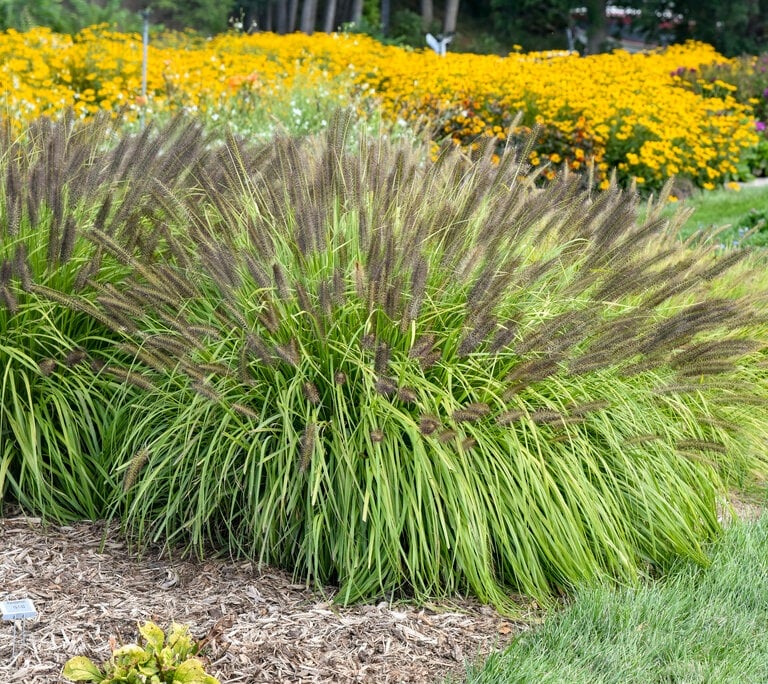

Proper soil preparation is key: enriching native sand with compost, peat, and perlite balances moisture retention and drainage. Planting to a depth of 30–40 cm encourages strong root development, while mulching preserves soil moisture and minimizes heat stress. Deep-rooted species accustomed to weekly irrigation develop resilience, thriving in the UAE’s environment without constant intervention.
Through careful species selection, informed placement, and thoughtful planting practices, landscapes in the UAE can be both visually captivating and inherently sustainable, reflecting a designer’s intent while standing the test of time
Soil and Planting Insights
By combining these species, a garden achieves height, texture, and seasonal interest, while maintaining sustainability and resilience. Layering trees, shrubs, groundcovers, and climbers creates shade for the soil, reduces water loss, and supports a self-sustaining landscape ecosystem.
Microclimate and Placement
Every outdoor space has distinct sun, shade, and heat reflection patterns. West-facing areas benefit from robust, heat-tolerant species, while shaded courtyards can host softer, foliage-rich plants. Hardscape-adjacent zones retain warmth, favoring resilient shrubs over delicate ornamentals. Strategic placement ensures plants thrive and the overall composition remains balanced and refined.
Hardscape & Structural Materials
Stone, Pavers, and Tiles
When selecting hardscape materials, prioritize those that can withstand UV exposure, heat, and salt. Light-colored stones are particularly effective at reducing heat absorption. Ensure that your chosen materials offer slip resistance and are expertly installed to maintain integrity and visual appeal.
Wood, Composite, and Metal
For features like decks, pergolas, and outdoor furniture, go for treated wood, durable composites, or coated metals to resist warping, corrosion, and decay. Quality materials here can elevate your space while withstanding the elements.
Mulch and Ground Covers
Utilizing organic mulch is a great way to keep soil moisture levels steady and suppress weeds. In arid environments, gravel or decorative aggregates can also serve as effective ground covers. Mulch not only lowers surface temperatures but also mitigates water evaporation, helping your plants thrive in the UAE's warm climate.
With the right selection of materials and plants, your landscape can flourish—resilient, beautiful, and tuned to survive in its unique environment.
Your landscape design should not only reflect your aesthetic preferences but also enhance your everyday living experience. The choice of design style will greatly affect factors like cost, maintenance, water usage, and durability. By selecting a style that resonates with you while considering your site’s unique characteristics and budget, you can create an inviting and functional outdoor space tailored to your needs.
Desert
This style emphasizes the use of native plants, rock, gravel, and minimal lawns or high-maintenance plants, characterized by muted tones. Its resilience makes it ideally suited for the UAE’s arid climate, requiring very low water and minimal upkeep. To avoid a stark or barren appearance, careful layering, strategic shading, and selective planting are recommended. Xeriscape gardens thrive in sandy soils and extreme heat, making them a sustainable and practical choice for long-term durability.
Modern Minimal
Characterized by clean lines, restrained color palettes, and hardscape-dominant layouts, this style emphasizes visual simplicity and elegance. Plant variety is kept minimal, and features are often geometric or sculptural. While it is generally easier to maintain, attention to material selection is critical: surfaces must resist high UV exposure and heat expansion. Integrating shade for plants and seating areas, along with careful orientation of hardscape elements, ensures comfort and longevity in the UAE sun.
Tropical
Lush, layered plantings with large-leaf foliage, palms, and occasional water features define this style, creating a resort-like atmosphere. While the abundant greenery provides natural cooling and visual richness, it demands careful irrigation management, soil preparation, and microclimate planning. In the UAE’s harsh sun, proper shade, wind protection, and heat-tolerant species are essential to prevent plant stress or failure, and ongoing maintenance is required to sustain its luxurious appearance.
Mediterranean
Featuring olive or citrus trees, structured planting beds, gravel or tiled pathways, and terracotta tones, Mediterranean-style landscapes balance aesthetic warmth with practicality. Trees provide natural shade, and stone surfaces moderate soil and ambient temperatures. The style offers moderate water demand and is suitable for private courtyards, patios, or larger garden spaces. Thoughtful plant layering, soil amendment, and sun-path consideration ensure healthy growth and long-term resilience.
Farmhouse Garden Style
Farmhouse gardens celebrate natural materials and an informal, inviting layout. Weathered wood, stone, and aged metal combine with loose planting schemes, gravel or flagstone pathways, climbing plants, flowering shrubs, and edible gardens to create a warm, countryside-inspired environment. Rustic furniture and earthy tones reinforce the sense of simplicity and authenticity.
Adapting for the UAE requires careful material and plant choices. Opt for hardy, heat-tolerant species that evoke the lushness of temperate gardens, and use reclaimed or treated wood and corrosion-resistant metals to withstand sand and humidity. Limit lawns in favor of gravel beds, raised planters, and pergolas for shade. While regular maintenance is needed to prevent natural materials from deteriorating, the resulting garden offers a rich, textural, and inviting alternative to sleek modern landscapes.
Design Styles & Usage: Choosing the Right Landscape for Your Lifestyle and Location
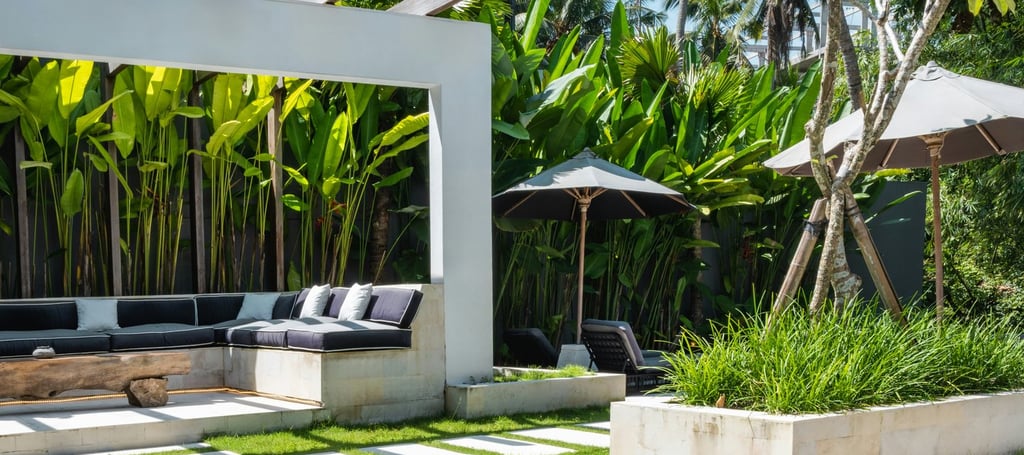

In an era marked by water scarcity, rising energy costs, and environmental challenges, adopting sustainable practices is essential for creating landscapes that thrive in the long term.
By incorporating native and drought-tolerant plants, you can significantly reduce both water consumption and maintenance efforts. These plants are well adapted to the local climate and require less care to flourish.
Implementing mulching, composting, and soil amendments is another effective strategy for enhancing soil health while minimizing water loss. These practices not only enrich the soil but also create a more resilient landscape that can withstand periods of drought.
Utilizing water-efficient irrigation systems such as drip irrigation, smart controllers, and timers can be transformative. Additionally, exploring options for greywater reuse can further enhance water efficiency, making your landscape more sustainable.
Consider your choice of materials carefully. Opt for lighter colours, permeable paving, and locally sourced materials to reduce transportation impacts and minimize heat absorption. These choices contribute both to the environmental footprint and the comfort of the landscape.
Similarly, incorporating shade and cooling strategies including trees, pergolas, trellises, or carefully maintained water features lowers ambient temperatures and improves usability, ensuring outdoor spaces remain comfortable even during the UAE’s hottest months.
By integrating these approaches, a landscape becomes not only visually striking but also resilient, efficient, and environmentally responsible, delivering long-term value and comfort.
Sustainability & Efficiency


Maintenance & Lifecycle
Even the most beautifully designed landscape can falter without proper maintenance. Landscaping is a long-term commitment that involves ongoing care beyond the initial installation. It’s essential to plan for the entire lifecycle of your garden.
Seasonal Rhythms: The UAE experiences distinct seasons, including extreme summer heat, transitional spring and fall, and milder winter months. Adjusting your watering and pruning schedules to align with these seasonal changes is crucial for optimal plant health.
Establishment Phase: The first one to two years are critical for your landscape's success. During this time, plants require extra attention—regular watering, mulching, and protection from sun and wind—to allow their roots to develop strong foundations.
Irrigation Monitoring & Adjusting: Utilizing soil moisture sensors and smart controllers is vital. Avoid blindly following your schedule; overwatering can lead to root rot and unnecessary water waste. Regular adjustments based on actual conditions can make a significant difference.
Pest and Disease Vigilance: Keep an eye out for pests and diseases, as heat-stressed plants are particularly vulnerable. Selecting native or well-adapted species can help minimize risks, and employing integrated pest management strategies will reduce the need for heavy chemicals.
Hardscape Upkeep: Regular maintenance of hardscape elements is essential for longevity. Clean stains, inspect joints, and reseal stone or grout as needed. Address shifting pavers promptly and ensure that lighting and fixtures remain waterproof and well-maintained.
By incorporating these maintenance practices, you’ll ensure that your landscape remains vibrant and thrives throughout its lifecycle.


Administrative and Technical Essentials
The foundation of a lasting landscape lies in precise technical planning and clear administrative oversight. Clearly defining the scope of work at the outset is essential: this encompasses design, materials, planting, irrigation, lighting, and any permits required. Establishing responsibilities and deliverables ensures all parties understand their role, minimizing confusion and preventing delays during implementation.
Navigating regulatory and municipality approvals is equally critical. Walls, water features, major constructions, and lighting installations must comply with local building codes. Addressing approvals early prevents costly modifications or project interruptions later.
Project phasing and timelines are central to smooth execution. Typically, hardscape is installed first, followed by soil preparation and irrigation, with planting completed last. Clear milestones — from base installation and irrigation setup to final planting — allow for coordinated progress and consistent quality control.
Warranties and guarantees provide protection for both plants and materials. Young plants are particularly vulnerable during establishment, while hardscape elements and irrigation systems may experience early defects. Explicitly outlining coverage for labour, materials, and maintenance responsibilities ensures expectations are aligned between client and contractor.
Budget transparency is another cornerstone. Beyond initial construction costs, ongoing water usage, maintenance, and potential replanting must be considered. Full clarity on material costs, labour, transport, and aftercare prevents unexpected expenses.
Finally, the experience and credentials of your contractor make a tangible difference. Selecting professionals familiar with the UAE’s heat, sand, soil conditions, and supply chains ensures materials and planting strategies are appropriate and sustainable. Reviewing portfolios of similar projects and evidence of ongoing maintenance support further safeguards the quality and longevity of your landscape.
A curated set of essentials to help you understand scope, quality, and long-term performance in the UAE.
1. Does your quote cover design drawings, materials, irrigation, lighting, and planting?
A comprehensive quote should clearly spell out what you’re paying for. In the UAE, this typically includes drawings, hardscape materials, lighting, irrigation, and the full planting works. If any of these elements are left vague or excluded, unexpected add-ons tend to appear later, especially with irrigation and lighting.
2. Can I review samples before you place any orders?
You should be able to see and approve what will go into your garden, from stone and tile finishes to decking, gravel, key plant varieties, and lighting fixtures. Reviewing samples is how you ensure materials are visually correct and suitable for our climate in terms of heat, UV exposure, and salt resistance.
3. Which parts of the work will be completed by subcontractors?
Many landscape companies in the UAE outsource irrigation, lighting, tiling, and pergola fabrication. It is important to know who is responsible for what because it helps you understand accountability, quality control, and how warranty claims will be handled later.
4. Will you design proper drainage with a 1–2% slope?
Proper grading is one of the most overlooked technical details in landscaping. A gentle slope (typically 1–2%) prevents water from pooling along villa walls, under tiles, or in shaded corners where mosquitoes thrive. Your contractor should be able to explain how water moves through the site and where it ultimately drains.
5. Does your plant palette include both native and adaptive species?
A resilient planting strategy in the UAE blends hardy natives with carefully selected adaptive ornamentals. You want a mix that handles heat, intense sun, sandy soil, and occasional humidity without constant replacements.
Native species (ghaf, sidr, desert grasses) for low maintenance
Heat-adaptive ornamentals (bougainvillea, plumeria, jasmine) for aesthetics
Shade-tolerant picks for courtyards
–Salt-tolerant varieties for coastal areas
If the palette leans too heavily toward delicate tropicals, expect higher water bills and a higher failure rate in summer.
6. Will you add root barriers near pools, paved areas, and villa walls?
Root barriers are essential when planting near anything that can crack or shift such as near pools, paving, retaining walls, and villa foundations. Fast-growing species, even the commonly used ficus, can cause significant damage without proper containment. Your contractor should specify where barriers are needed and what material they will use.
7. Which items are covered under warranty?
Warranties vary widely, so clarity matters. Plants are usually covered for the establishment period (often 3–6 months). Irrigation systems typically have workmanship coverage for leaks and faulty components, while lighting fixtures follow the manufacturer’s warranty. Hardscape warranties depend on the material but should at least cover workmanship. Make sure all guarantees are documented in writing.
8. Can you show me landscaping permits / approvals?
In many UAE communities, even small landscape upgrades require NOC submissions, drawings, and material approvals. Your contractor should handle these on your behalf and provide copies of all submitted documents. Having this paperwork ensures compliance with community guidelines and prevents delays, fines, or forced reinstatement later.
9. Where do you source your stones?
Stone quality varies widely in the UAE. Your contractor should specify whether materials are sourced locally (across any of the emirates) or imported. Sourcing matters because density, porosity, and salt resistance directly affect colour fade, cracking, and long-term durability. Ask to see the supplier, not just a sample, for assurance of consistency.
10. Do you plan drip irrigation?
In the UAE, a well-designed system typically includes drip lines for shrubs and groundcovers, and bubblers for trees. Drip irrigation reduces water waste, keeps foliage dry (preventing fungal issues), and delivers moisture directly to the root zone. Your contractor should show where each zone is placed, how it’s controlled, and whether it meets your community’s water-use regulations.
11. Which plants need shade?
Many ornamentals require temporary shade during establishment, especially when planted in peak heat. Bougainvillea, plumeria, jasmine, hibiscus, and most tropicals benefit from filtered light until roots stabilize. Sensitive groundcovers and new lawn areas also need protective shading nets for the first 2–4 weeks. Your contractor should outline which areas need temporary shade cloth and for how long.
12. What materials will last longest in this heat?
Durability in the UAE comes down to UV stability, thermal expansion, and salt resistance. Porcelain tiles, natural granites, porcelain decking, aluminium pergolas, and powder-coated metals perform exceptionally well. Avoid soft limestones, untreated steel, and low-grade woods—they fade, crack, or warp within a season. Your contractor should recommend materials proven to withstand 50°C+ temperatures.
13. How is the project phased?
A well-run landscape project follows a clear sequence:
Site prep and demolitions
Leveling, drainage, and underground services
Irrigation and electrical works
Hardscape installation (tiles, pergolas, pathways)
Softscape preparation (soil, mulching, planting pits)
Planting, lighting placement, testing
This structure minimizes rework, prevents damage to finished surfaces, and keeps the project on schedule.
14. Does your quote include electrical and planting labour?
Labour for electrical works (lighting cables, outdoor sockets, pumps) and planting (trees, shrubs, soil amendment) should be explicitly listed. Some contractors quote only materials and rely on provisional sums for labour, which leads to cost increases later. A complete quote should outline manpower, installation methods, and associated consumables.
15. How much maintenance will this need once it’s done?
Every landscape in the UAE requires regular care due to heat, dust, and fast growth patterns. Typical maintenance includes pruning, fertilising, irrigation checks, pest control, and lawn care. Low-maintenance does not mean “no maintenance”, it means the plant palette and materials are chosen to limit weekly intervention, reduce water usage, and remain stable across seasons.
16. What’s the replacement plan if any plants fail in the first few months?
Most contractors provide an establishment-period guarantee. If plants fail due to poor installation, incorrect irrigation, or soil issues, replacements should be covered at no cost. If failure is due to neglect or extreme weather, a reduced-cost replacement is typically offered. Make sure the timeline and conditions are clearly documented.
17. How often should I expect to prune or maintain this landscape?
Shrubs and hedges in the UAE generally need trimming every 4–6 weeks in summer, and every 6–8 weeks in winter. Fast-growing species like bougainvillea require more frequent shaping. Trees need seasonal structural pruning, while lawns require weekly mowing in peak season. Your contractor should outline a realistic schedule based on your exact plant palette and design.
Questions to Ask Your Contractor
This guide serves as your blueprint to achieve a stunning landscape that will withstand the rigors of the first summer ensuring no scorched grass or dead shrubs. If you're ready to delve into designs, materials, or budgeting, our team is here to assist you every step of the way.

